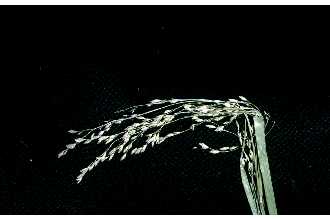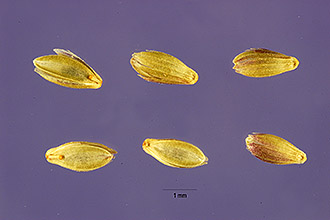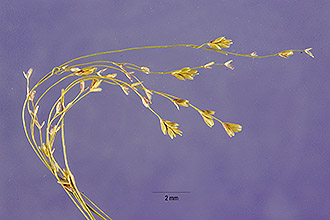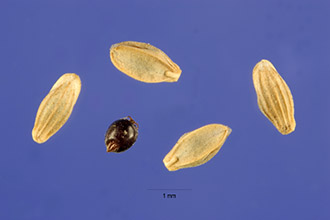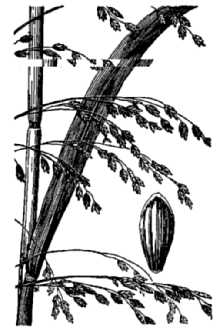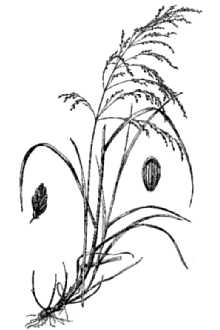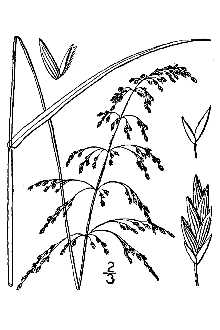Glyceria striata (Lam.) Hitchc. ssp. stricta (Scribn.) Hultén
Scientific Name: Glyceria striata (Lam.) Hitchc. ssp. stricta (Scribn.) Hultén
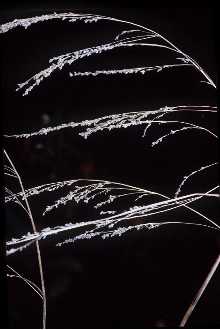
| General Information | |
|---|---|
| Usda Symbol | GLSTS3 |
| Group | Monocot |
| Life Cycle | Perennial |
| Growth Habits | Graminoid |
| Native Locations | GLSTS3 |
Plant Guide
Use a soil moisture meter to monitor the soil moisture where Glyceria striata (Lam.) Hitchc. ssp. stricta (Scribn.) Hultén is planted.
Fact Sheet
Alternative Names
Alternate Common Names: tall mannagrass Alternate Scientific Names: Glyceria elata, Glyceria nervata, Glyceria striata ssp. stricta, Glyceria striata var. stricta, Panicularia nervata, Panicularia striata
Uses
Fowl mannagrass is a rapidly establishing native species suitable for restoration of swamps, the edges of marshes, ponds, and streams, and other wetland plant communities where an herbaceous understory is desired, It has versatility for use along creeks and ditch bottoms where exposure may vary from full sun to dense shade, thereby improving soil stability beyond the use of woody plants alone, Where this species dominates, herbage production is high, Palatability of G, striata is rated good to very good for cattle and horses which consume both flower stems and leaves, It is rated fair to good for sheep which tend to use only the leaves, The seed is food for waterfowl and birds while the foliage and tall stems provide good wildlife cover, Foliage is seasonally grazed at a light to heavy rate by deer, muskrat, and bears, Elk can make minor use of it as well, Fowl mannagrass may be applicable to seeding mixtures targeted to improve species richness and exclude reed canarygrass (Phalaris arundinacea) prior to its invasion, Use soil moisture sensors to measure the soil moisture of Glyceria striata (Lam.) Hitchc. ssp. stricta (Scribn.) Hultén., It is occasionally planted as an ornamental in and around backyard ponds,
Status
Please consult the PLANTS Web site and your State Department of Natural Resources for this plant’s current status (e.g. threatened or endangered species, state noxious status, and wetland indicator values).
Description and Adaptation
Adaptation
Adaptation
In the Pacific Northwest, fowl mannagrass is a long-lived, cool season perennial bunchgrass with somewhat succulent stems (culms) that reach a height of 100 to 180 cm. The form is erect, robust, and clumpy despite the production of slow growing rhizomes or underground stems. Rate of spread may vary among populations. Leaf blades are soft, ribbon-like, 6 to 12 mm wide and 15 to 25 cm long. The flowerhead (panicle) is loose, broad, pyramid-like, and 8 to 27 cm long with spreading and drooping branches. Populations previously described for G. striata include plants that are shorter and tougher with smaller leaves (2 to 5 mm wide) and flower heads that are more closed. G. striata occurs across most of North America. Fowl mannagrass distribution from USDA-NRCS PLANTS Database. Key to identification: Fowl mannagrass can be easily confused with reed mannagrass (Glyceria grandis), which has smoother leaves and lacks its slightly rough texture. Others mannagrasses are easier to distinguish, but a botanical key should be consulted. Line drawing of fowl mannagrass reprinted with permission, University of Washington Press. Relative abundance in the wild: Seed ripens in July or August and retention within the flower head is fair to good. Collections can be readily made along wet forest road ditches, but access can be difficult along streams or in denser, swampy brush where this species is commonly found. Adaptation: Fowl mannagrass occurs widely in bogs, seeps, wet woods, thickets or swampy areas, shaded ditches, and along or in streams. It may occasionally be found growing in full sun on summer damp soils as well as in standing water. Reportedly, this species is best adapted to freshwater, semi-aquatic habitats (G. elata) or those that are irregularly to seasonally flooded and saturated for up to 25% of the growing season (G. striata). However, some plants have been observed to thrive and flower under continuous inundation (1-10 cm) for several years. Fowl mannagrass tolerates open areas but prefers shady habitats. It may occur as single plants, small colonies, or larger stands that dominate the understory of ash swales as well as willow, aspen, and other wetland forest or shrub communities. Soils range from organic to mineral with a pH of 4 (acidic) to 8 (slightly alkaline). This species does not tolerate salinity and needs moderately good fertility. This species is very shade tolerant, similar to reed mannagrass, yet it can be grown in full sun to produce substantial seed.
Establishment
The presence of seed dormancy, if any, may vary among populations. Seeds can germinate within two to three weeks without treatment, but 14 to 30 days of cold moist stratification (moist pre-chilling) has resulted in faster germination, although not necessarily higher rates. Others report the need for 150 days of stratification in cold water. Fall sowing is preferred if dormancy is known or uncertain. Seed hulls readily detach but removal is unnecessary. There are approximately 1,600,000 seeds per pound with hulls intact. A seeding rate of one pound pure live seed per acre will result is about 37 live seeds per square foot. Seeding rates depend on methods used, objectives, and site conditions.
Management
Sites where fowl mannagrass occurs are typically too wet for grazing when the herbage is most succulent. Therefore, access must be deferred until late in the season when soils are drier and quality has declined somewhat. Tolerance to fire and heavy grazing is not well documented. Fowl mannagrass can be grown for seed on upland sites with medium to fine textured soils if regular irrigation is applied in summer and fall.
Pests and Potential Problems
Glyceria striata is susceptible to fungal pathogens such as Epichloe glyceriae, which causes floral castration, and Ustilago striiformis, better known as stripe smut. Fungicides may be needed for control. Consult with your local Extension Service agent, plant disease control handbook, or other experts for advice.
Environmental Concerns
Some strains or populations of G. striata may contain cynogenetic compounds. Cyanide poisoning has been reported in cattle from both fowl and reed mannagrass, so caution is advised for livestock utilization. Other species of mannagrass are described as weedy in certain crops or wet areas, but concerns for fowl mannagrass are not widely known. Cultivars, Improved, and Selected Materials (and area of origin) Seed sources and plants are regularly available throughout much of the United States. Prepared By: Dale Darris, USDA NRCS Plant Materials Center, Corvallis, Oregon
Plant Traits
Growth Requirements
| Temperature, Minimum (°F) | -35 |
|---|---|
| Adapted to Coarse Textured Soils | No |
| Adapted to Fine Textured Soils | Yes |
| Adapted to Medium Textured Soils | Yes |
| Anaerobic Tolerance | High |
| CaCO3 Tolerance | Medium |
| Cold Stratification Required | No |
| Drought Tolerance | Low |
| Fertility Requirement | Medium |
| Fire Tolerance | Low |
| Frost Free Days, Minimum | 100 |
| Hedge Tolerance | None |
| Moisture Use | Medium |
| pH, Maximum | 8.0 |
| pH, Minimum | 4.0 |
| Planting Density per Acre, Maxim | 7856 |
| Planting Density per Acre, Minim | 3475 |
| Precipitation, Maximum | 60 |
| Precipitation, Minimum | 10 |
| Root Depth, Minimum (inches) | 4 |
| Salinity Tolerance | None |
| Shade Tolerance | Tolerant |
Morphology/Physiology
| After Harvest Regrowth Rate | Slow |
|---|---|
| Toxicity | None |
| Resprout Ability | No |
| Shape and Orientation | Semi-Erect |
| Active Growth Period | Spring |
| Bloat | None |
| Coppice Potential | No |
| Fall Conspicuous | No |
| Fire Resistant | No |
| Flower Color | Green |
| Flower Conspicuous | No |
| Foliage Color | Green |
| Foliage Porosity Summer | Moderate |
| Foliage Porosity Winter | Porous |
| Fruit/Seed Color | Red |
| Nitrogen Fixation | None |
| Low Growing Grass | No |
| Lifespan | Short |
| Leaf Retention | No |
| Known Allelopath | No |
| Height, Mature (feet) | 5.7 |
| Growth Rate | Moderate |
| Growth Form | Rhizomatous |
| Fruit/Seed Conspicuous | No |
| Foliage Texture | Fine |
Reproduction
| Vegetative Spread Rate | Slow |
|---|---|
| Small Grain | No |
| Seedling Vigor | Medium |
| Seed Spread Rate | Moderate |
| Fruit/Seed Period End | Fall |
| Propagated by Tubers | No |
| Propagated by Sprigs | Yes |
| Propagated by Sod | No |
| Propagated by Seed | No |
| Propagated by Cuttings | No |
| Propagated by Container | No |
| Propagated by Bulb | No |
| Propagated by Bare Root | No |
| Fruit/Seed Persistence | No |
| Fruit/Seed Period Begin | Spring |
| Fruit/Seed Abundance | Medium |
| Commercial Availability | Routinely Available |
| Bloom Period | Early Summer |
| Propagated by Corm | No |
Suitability/Use
| Veneer Product | No |
|---|---|
| Pulpwood Product | No |
| Protein Potential | Medium |
| Post Product | No |
| Palatable Human | No |
| Palatable Graze Animal | High |
| Palatable Browse Animal | Low |
| Nursery Stock Product | No |
| Naval Store Product | No |
| Lumber Product | No |
| Fodder Product | No |
| Christmas Tree Product | No |
| Berry/Nut/Seed Product | No |
